GeekBuying sent me one of their Tronsmart Orion R28 Meta (Beta) Android TV boxes powered by Rockchip RK3288 SoC. This model comes with 2GB DDR3, 16 eMMC, and 802.11 b/g/n/ac Wi-Fi. R28 Mega is the mid-range model, and there are two others models R28 Pro (entre-level) and R28 Telos (premium). I’ve already listed specifications for the three Tronsmart Orion R28 models. Today, I’ll show some picture of the device, and the board to find out more about the design of the product. Before reviewing the product in another post, I’ll probably build the image using the provided Android 4.4 SDK (provided I can download it), and perform the full review next week with the resulting firmware.
Tronsmart Orion Meta R28 Unboxing
I’ve received the parcel via DHL within 2 days. The same package will be used for all three models, but you’ll have a sticker on the side for Pro, Meta or Telos, as well as specifications at the back with options for 2 or 4 GB RAM, 8, 16 or 32 GB eMMC, and 802.11 a/b/g/n/ac or 802.11 b/g/n.
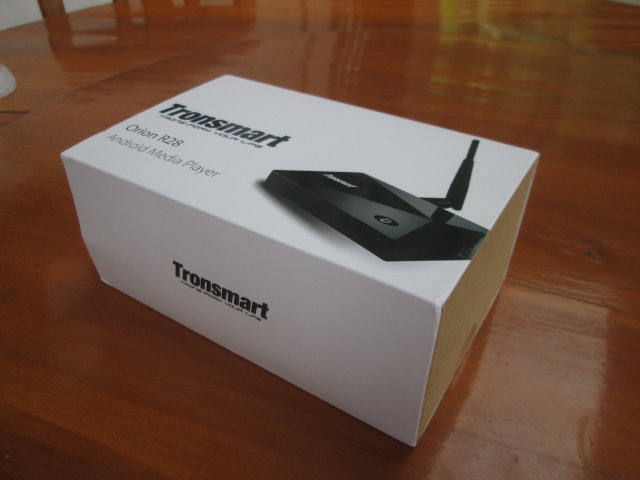 The box comes with an external Wi-Fi antenna, a IR remote control requiring 2x AAA batteries (not included) a micro USB to USB cable, an HDMI cable, and a 5V/3A power adapter. There’s also a user’s manual in English that I forgot to include in the picture below.
The box comes with an external Wi-Fi antenna, a IR remote control requiring 2x AAA batteries (not included) a micro USB to USB cable, an HDMI cable, and a 5V/3A power adapter. There’s also a user’s manual in English that I forgot to include in the picture below.
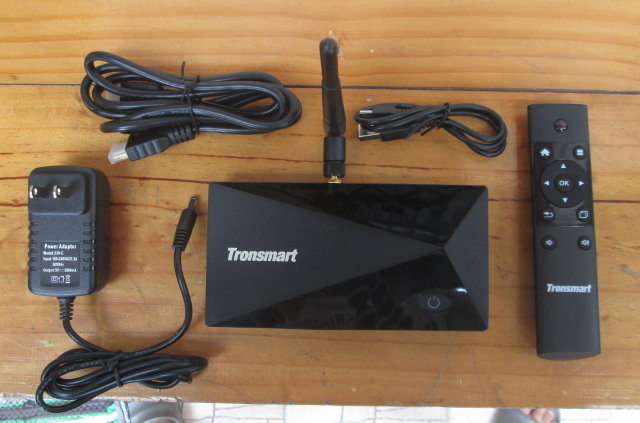
There’s a new good trend for power buttons which are now located on the top of the boxes that I recently received, and it’s the same for Orion R28. On the front panel, there’s just the window for the IR receiver, two USB 2.0 ports and a micro SD slot can be found on the side, and the rear panel has most of the ports: DC in barrel, AV output, optical S/PDIF, Gigabit Ethernet, antenna connector, HDMI 2.0 output, another USB 2.0 host port, and a micro USB OTG port. A micro SD card with the SDK was supposed to be included, but they forgot to include it in my package, so instead I’ll have to download it (link provided at the end of this post).
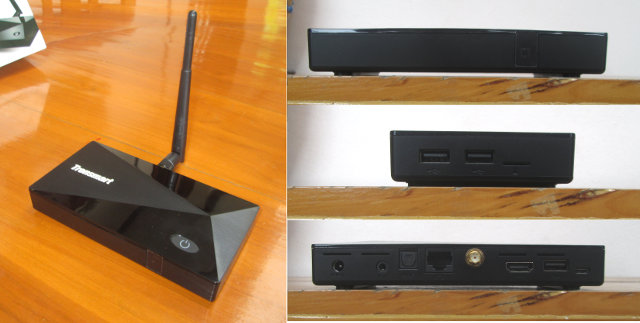
Markings for FCC and CE are written on the package, but on the bottom of the enclosure I can only see a CE marking.
Unboxing video:
Tronsmart Orion Meta R28 Board
Now let’s open the enclosure. Removing the two rubbers pads on the bottom reveals three screws. After I had untightned them I expected the box to open easily, but it would not come off despite all my efforts… That’s because there’s another screw, under the “Tronsmart Orion R28” sticked. After you remove that one, it becomes much easier…
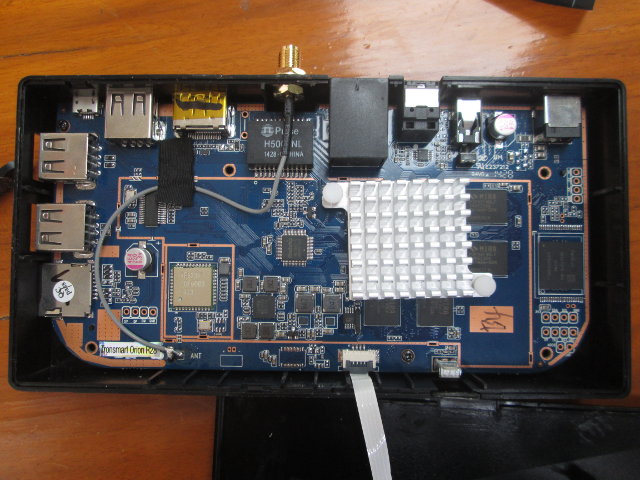
The wireless module is indeed AP6335 which supports 802.11 b/g/n, 802.11ac, and Bluetooth 4.0. Sandisk SDIN7DP4-16G is a 16GB eMMC, and RK1000 chip is used for composite output. Access to the serial console should be very easy since there are the four through holes for Tx, Rx, GND and 5V on the top right. Other accessible I/Os are I2C and UART3 (bottom right), and 4 more pins for USB. The board name is not readable as they’ve stuck a “Tronsmart Orion R28” sticker on top.
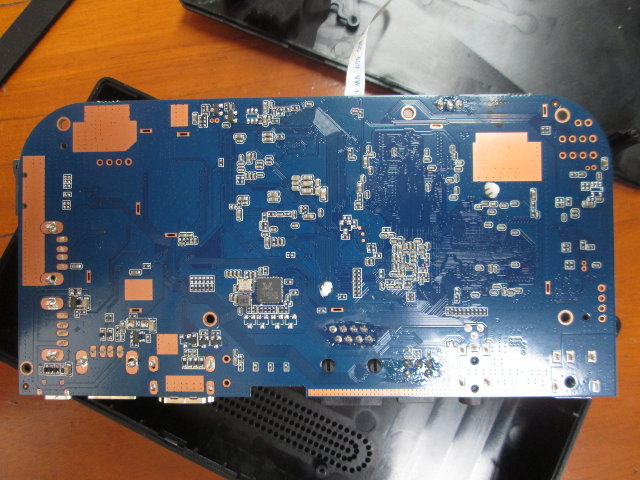
The only noticeable chip on the back of the board is Realtek RTL8211E Gigabit Ethernet transceiver.
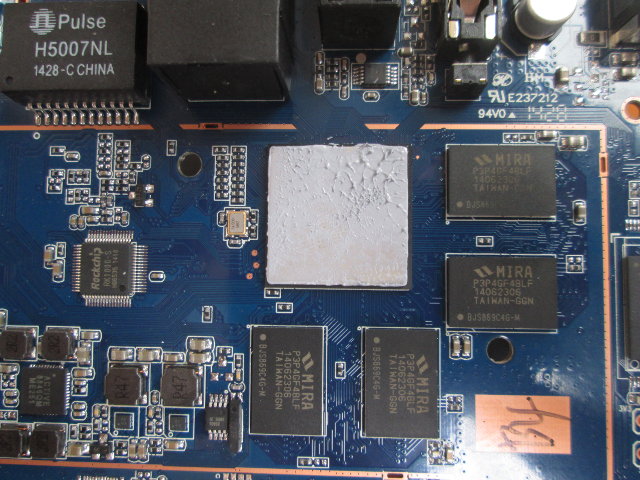
Removing the heatsink is easy as there’s just two small bits with springs holding it. Instead of using thermal pad like in Kingnovel K-R68, there’s some thermal paste between the heatsink and Rockchip RK3288. Four DDR3 memory chips (MIRA P3P4GF4BLF) are used to get 2GB RAM.
That’s all for today,. The next step is to download the Android SDK (if somebody can re-upload it to mega.co.nz, it would be help Link to mega.co.nz mirror. Thanks Kostas!), build the Android image, and flash it to the box. You can pre-order the final version of Tronsmart Orion R28 Meta for $119.99 on GeekBuying, but if you don’t need 802.11ac, and can do with 8GB eMMC instead of 16GB, the Orion R28 Pro goes for $99.99.

Jean-Luc started CNX Software in 2010 as a part-time endeavor, before quitting his job as a software engineering manager, and starting to write daily news, and reviews full time later in 2011.
Support CNX Software! Donate via cryptocurrencies, become a Patron on Patreon, or purchase goods on Amazon or Aliexpress





Can you compare video quality of RK3288 vs Amlogic S802, please ? Because RK3188 was not good even if you compare with dual-core Amlogic 🙁 …
Fantastic! The news that I was waiting for! Looking forward to see some tests. Is there any news regarding when Telos will be available? The 32GB would really come handy to me!
Here is the: Android SDK hosted on mega.co.nz:
https://mega.co.nz/#!1t8HVIYK!RqifnmnsJ8ADpRzz3AgK14jIAoTBrOOiNpO8QfRlHKs
🙂
@Vlad
The problem is that I don’t know how to compare video quality in an objective manner.
One way would be to have two identical TVs side by side, one with RK3288, the other with S802, and and several people to watch a few videos, and give their “quality rating” between 1 and 10. But it’s not something I can realistically organize. If you have some ideas for testing, I’m open to it.
Having said that, based on my *current* XBMC experience, S802 is much better than RK3288 in terms of supported codecs, and some videos in RK3288 have A/V sync issues, some artifacts, skipped framed, etc…
The XBMC provided with Orion R28 appears to be very similar to the one I tested in K-R68, and quick test showed that VC1 and H.265 can’t be played either.
@Tadej
I will take some time because I want to make sure the image built with the SDK can indeed be used with the board, but I have problems with my ISP, so downloading is tricky right now… I’m also waiting for my TP-Link Archer C7 (clone) router from China to test 802.11ac.
@Kostas
Thanks that was fast!
A nicely produced video review -> https://www.youtube.com/watch?v=eir5DU4nMm8
OK, gotta ask as it has been mentioned/featured on recent reviews… The composite output, do people really still use that for anything?
My last era of using that was in mid 90’s with Amiga 1200/4000, I have not utilized any of that analog TV stuff since, do use VGA occasionally via backup system for backup/emergencies, but otherwise everything since is digital, let it be DisplayPort, HDMI, or DVI.
Only thing with composite input it an telly perfectly capable of 1080p HDMI, so why would anyone willingly subject him/herself into composite/svideo/RGB/SCART-era things for any real use?
I’m just a digital snob that doesn’t understand that people still use CRTs for anything besides pollution?
Anyway, two improvements does strike my fancy about this box, the new PSU model they have started to use is way better, that those 5V/2A wall warts of yesteryear, and that they finally have started to use generic chipset coolers that can be found everywhere… When they understand to start overkilling them with milled billet (a’la Apple “Unibody”) cases for the high-end versions… Wishful thinking. 😉
You never can have “too much” passive cooling.
@cnxsoft
Glad that helped, thanks for your work on making reviews for various Android TV boxes, they are very useful!
The Orion R28 Meta Board is the same as Beelink’s R89, proof see this post
http://www.freaktab.com/showthread.php?13272-Beelink-R89-RK3288-Cortex-A17-Mali-T7-4Kx2K-RGMII-HDMI2-0-supported-by-ODM-amp-developers&p=185995&viewfull=1#post185995
This is also sold as a UBOX R89 The board is manufactured by Netxeon,
Lots more info over on freaktab,
When you say you need to download android sdk, does this mean it doesn’t come with any firmware installed? You have to build an android image and place it on a removable card for it to boot?
In terms of benchmark performance, wouldn’t executing out of eMMC be much slower than if the box could boot an image from internal flash?
@ben
The box comes pre-loaded with Android firmware, but I want to make sure the SDK runs as advertized. Nexteon had released SDKs for their RK3188 devices that did not seem to work as expected, so I want to make sure it works this time.
First initial patch for hardware HEVC decoding on Android now submitted to XBMC/Kodi
https://github.com/xbmc/xbmc/pull/5374
Hi,
I’ve Terratec HTC USB TV tuner. I’d like to know if is possible to convert a EM28XX linux driver to Android driver so it can be used in Android TV box?